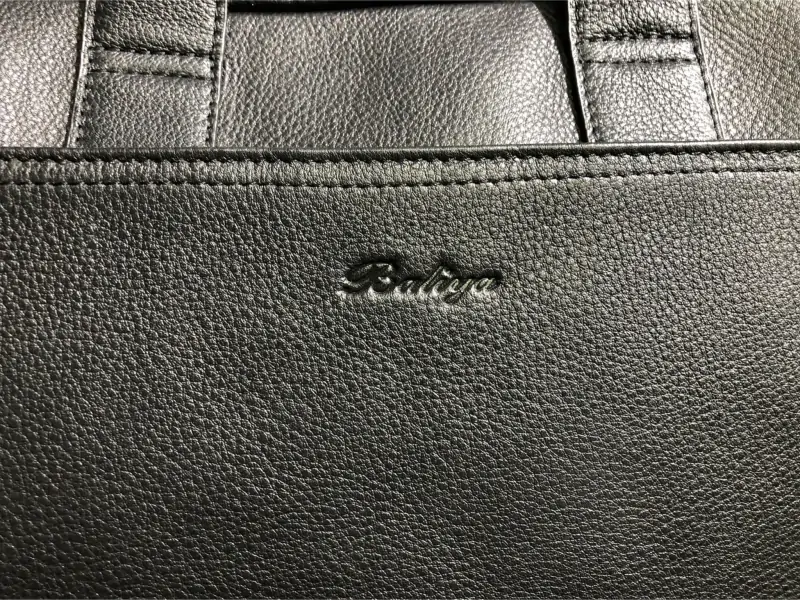In the world of premium accessories, branding plays a central role in how customers perceive value. When it comes to leather goods, two of the most widely used logo application techniques are hot stamping and embossing. Both methods help distinguish products, but the discussion of hot stamping vs embossing often leaves designers and brand owners questioning which method truly enhances the appeal of their creations.
A carefully chosen logo application method can elevate your brand identity, create a lasting impression, and even influence purchasing decisions. Understanding the differences between hot stamping vs embossing allows you to select the approach that best aligns with your leather bags and your overall branding strategy.
Hot stamping involves applying heat and pressure to imprint a logo onto leather. In many cases, metallic foils such as gold or silver are added to highlight the logo and give it a luxurious finish. This technique is commonly used for custom leather bags with logo, as it ensures sharp definition and an eye-catching appearance.
The debate of hot stamping vs embossing begins with considering the level of visibility. Hot stamping produces a vibrant and bold mark, often associated with premium products and luxury branding.

One major advantage of hot stamping is its high-end visual appeal. A metallic finish can give leather bags a distinctive look that stands out on retail shelves or online platforms. Additionally, hot stamping is durable when applied correctly, making it ideal for logos that need to maintain their brilliance over time.
When evaluating hot stamping vs embossing, hot stamping is often chosen by brands aiming to project a sense of exclusivity and sophistication.

Embossing, in contrast, uses pressure and shaped dies to create a raised or recessed logo impression directly onto the leather surface. No foil or additional material is necessary, which makes the technique subtle and timeless. This natural impression gives embossed logos a tactile quality, inviting customers to feel the branding.
In the conversation of hot stamping vs embossing, embossing stands out for its understated elegance. It complements minimalist branding approaches while still enhancing the overall product design.
The primary benefit of embossing lies in its subtlety and durability. Since no foil is used, the logo blends seamlessly with the leather and does not risk peeling or fading. This makes embossing a popular choice for designers who value simplicity and long-lasting identity.
Looking at hot stamping vs embossing, embossing offers brands a way to build authenticity through subtle design rather than flashy presentation.
When it comes to visibility, hot stamping vs embossing creates very different results. Hot stamping attracts attention quickly, making it a great choice for high-impact branding. Embossing, meanwhile, offers a more discreet look that speaks to refined taste and understated luxury.
Both methods influence customer perception. Hot stamping suggests boldness and prestige, while embossing suggests heritage, craftsmanship, and timeless value.
Choosing between hot stamping vs embossing also depends on your target audience. A brand aiming for modern luxury may prefer hot stamping, while a brand focused on heritage and tradition may lean toward embossing. Aligning the technique with your brand story ensures a stronger emotional connection with customers.
While hot stamping offers striking visuals, it does require careful execution. Poor application can cause foil to peel or fade over time, especially on heavily used products like handbags. That said, when done by skilled artisans, hot stamping retains its brilliance and continues to stand out even after years of use.
This makes the hot stamping vs embossing debate especially relevant for brands selling leather bags meant for daily wear.
Embossed logos are naturally resistant to wear and tear because they are physically pressed into the leather. Unlike hot stamping, there is no additional material to deteriorate. For this reason, embossing often outperforms hot stamping in terms of resilience.
Brands weighing hot stamping vs embossing need to consider the product’s purpose—whether longevity or instant visual impact is more important.
Hot stamping can be slightly more expensive due to the additional materials (foils) and precise equipment required. For small runs, the setup cost may be relatively high, but the luxurious finish often justifies the expense for premium brands.
This makes the financial aspect of hot stamping vs embossing an important factor for emerging designers who must balance branding goals with production budgets.
Embossing is generally more cost-efficient since it requires no foil. Once the dies are created, embossing can be replicated across many items with minimal additional expense. This efficiency makes embossing attractive for brands that focus on scalability while maintaining elegance.
The hot stamping vs embossing debate highlights that while hot stamping can elevate exclusivity, embossing provides cost advantages for long-term branding strategies.
In deciding between hot stamping vs embossing, it’s essential to think about how your logo contributes to overall branding. Techniques like hot stamping can immediately draw attention, which is beneficial for new companies aiming to build leather bag brand awareness. Embossing, by contrast, communicates subtlety and heritage—perfect for brands that rely on tradition and craftsmanship.
Some brands even combine the two methods to maximize impact. For example, hot stamping might be used for limited-edition products, while embossing is used for main collections. This balance allows brands to adapt hot stamping vs embossing to different audiences and product lines without diluting their identity.
At the end of the day, the hot stamping vs embossing decision comes down to your brand’s vision, audience, and long-term goals. Hot stamping delivers luxury and instant recognition, while embossing offers durability and understated elegance.
By carefully aligning your logo technique with your branding strategy—whether through custom leather bags with logo or timeless embossed designs—you ensure that every leather bag you produce tells a consistent story. The choice between hot stamping vs embossing is not about which is universally better, but about which best supports your brand’s identity and adds lasting value to your leather goods.